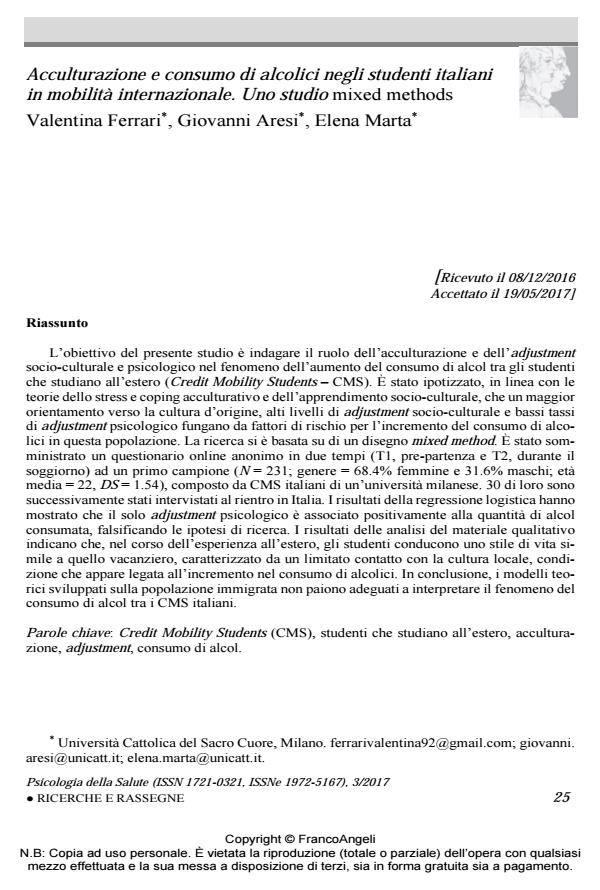Acculturazione e consumo di alcolici negli studenti italiani in mobilità internazionale. Uno studio mixed methods
Titolo Rivista PSICOLOGIA DELLA SALUTE
Autori/Curatori Valentina Ferrari, Giovanni Aresi, Elena Marta
Anno di pubblicazione 2017 Fascicolo 2017/3
Lingua Italiano Numero pagine 27 P. 25-51 Dimensione file 306 KB
DOI 10.3280/PDS2017-003002
Il DOI è il codice a barre della proprietà intellettuale: per saperne di più
clicca qui
Qui sotto puoi vedere in anteprima la prima pagina di questo articolo.
Se questo articolo ti interessa, lo puoi acquistare (e scaricare in formato pdf) seguendo le facili indicazioni per acquistare il download credit. Acquista Download Credits per scaricare questo Articolo in formato PDF

FrancoAngeli è membro della Publishers International Linking Association, Inc (PILA)associazione indipendente e non profit per facilitare (attraverso i servizi tecnologici implementati da CrossRef.org) l’accesso degli studiosi ai contenuti digitali nelle pubblicazioni professionali e scientifiche
L’obiettivo del presente studio è indagare il ruolo dell’acculturazione e dell’adjustment socio-culturale e psicologico nel fenomeno dell’aumento del consumo di alcol tra gli studenti che studiano all’estero (Credit Mobility Students ? CMS). È stato ipotizzato, in linea con le teorie dello stress e coping acculturativo e dell’apprendimento socio-culturale, che un maggior orientamento verso la cultura d’origine, alti livelli di adjustment socio-culturale e bassi tassi di adjustment psicologico fungano da fattori di rischio per l’incremento del consumo di alcolici in questa popolazione. La ricerca si è basata su di un disegno mixed method. È stato somministrato un questionario online anonimo in due tempi (T1, pre-partenza e T2, durante il soggiorno) ad un primo campione (N = 231; genere = 68.4% femmine e 31.6% maschi; età media = 22, DS = 1.54), composto da CMS italiani di un’università milanese. 30 di loro sono successivamente stati intervistati al rientro in Italia. I risultati della regressione logistica hanno mostrato che il solo adjustment psicologico è associato positivamente alla quantità di alcol consumata, falsificando le ipotesi di ricerca. I risultati delle analisi del materiale qualitativo indicano che, nel corso dell’esperienza all’estero, gli studenti conducono uno stile di vita simile a quello vacanziero, caratterizzato da un limitato contatto con la cultura locale, condizione che appare legata all’incremento nel consumo di alcolici. In conclusione, i modelli teorici sviluppati sulla popolazione immigrata non paiono adeguati a interpretare il fenomeno del consumo di alcol tra i CMS italiani.�
Parole chiave:Credit Mobility Students (CMS), studenti che studiano all’estero, acculturazione, adjustment, consumo di alcol
- Analysing change among study abroad students. A novel application of the person-centred approach to alcohol use patterns Giovanni Aresi, Angela Sorgente, Simon C. Moore, Elena Marta, in International Journal of Intercultural Relations /2021 pp.220
DOI: 10.1016/j.ijintrel.2021.04.006 - The Palgrave Handbook of Youth Mobility and Educational Migration Giovanni Aresi, Elena Marta, Simon C. Moore, pp.441 (ISBN:978-3-030-99446-4)
- The Palgrave Handbook of Youth Mobility and Educational Migration Giovanni Aresi, Elena Marta, Simon C. Moore, pp.427 (ISBN:978-3-030-64234-1)
Valentina Ferrari, Giovanni Aresi, Elena Marta, Acculturazione e consumo di alcolici negli studenti italiani in mobilità internazionale. Uno studio mixed methods in "PSICOLOGIA DELLA SALUTE" 3/2017, pp 25-51, DOI: 10.3280/PDS2017-003002